Use the following link to download the April 13, 2024 issue of the syəcəb
Category: Tulalip News
Hawaii/Tulalip connections

By Lilly Jefferson, Tulalip News Contributor
ʔi čəxʷ, ʔəsčal čəxʷ. Lilly Jefferson tsi s?sda, I recently returned from a trip to Hawaii and wanted to share things I saw and learned.
My family likes to snorkel so we went to tons of beaches while we were there. We went to a beach every day and always left the house with our swimsuits on because we were prepared. But I remember this one beach we went to, we were all in the water snorkeling and we heard this lady yelling at everyone and when we looked up we saw a seal resting on shore. It was awesome! There were other seals, too, all resting around the beach and ten sea turtles were coming ashore.
While we were in Hawaii, we visited the big island and were pleasantly surprised to see Toni Jo Gobin. She shared with me that she moved from Tulalip to Hawaii in June 2016 and absolutely loves her life there. She was willing to share what it’s like calling Hawaii home.
“It’s a blessing to live in Hawaii,” said Tulalip tribal member, Toni Jo Gobin. “It feels like home, it feels like living off the rez. I was a little nervous moving here by myself, just me and my son. But it’s just like anywhere you move where you don’t have no family no ties, no connection. It’s a little scary at first, but we were blessed us with a good place to stay and a good landlord. I thank god for putting people in my life that took me under their wing and introduced me to all kinds of stuff over here that made me feel welcome.”
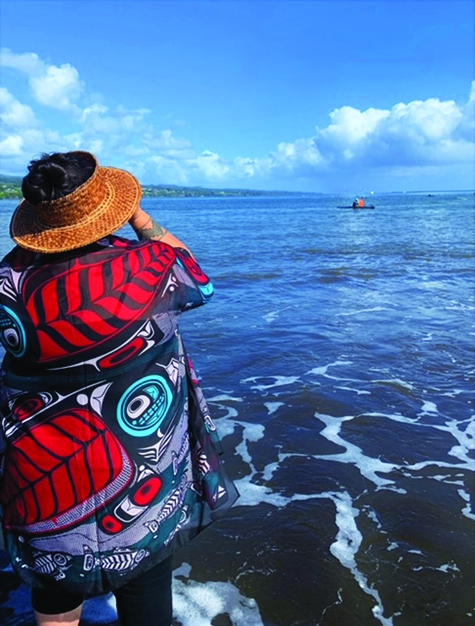
Hawaiian culture is so similar to our Coast Salish culture. For example, they weave leaves from palm trees for headbands and we weave with strips of cedar wood. They use the ukulele, large gourd drums called ipu hulas, and the pahu a bass drum, while we use hide drums, rattles, and clappers.
They even have canoe races. When I was there we met up with Toni Jo Gobin and learned her son has a canoe. It was so cool and they let us go on it. We just so happened to be there when the island hosted their own canoe races! It was so awesome to see all the canoes on the beach. There were so many people racing.
Hawaiian art even resembles Coast Salish art, too. Each piece of art that I came across had its own story. One common art piece you can see in Hawai’i is the Polynesian Triangle. The triangle represents cultural geography, such as Hawaii in the North, Eastern Island/Rapa Nui, and New Zealand/Aotearoa. *
Here in Tulalip, there is a lot of talk of colonization and we tend to think it has only happened to tribes. Really it has happened all around the world. For example, in Hawai’i in 1896 there was a language ban that caused several generations to lose part of their culture. Land and water were also taken from them for military bases, resorts, urbanization, and plantation agriculture. *
Even their Hula dance has been culturally appropriated. It was taken from Hawaiian people and made ornamental for tourism. Meaning the dance had been a showcase for tourists. Hawaii is the most isolated island in the world. It has been overrun by settlers. During World War II, Hawaii was under martial law for seven years. Hundreds of thousands of acres of land were confiscated.
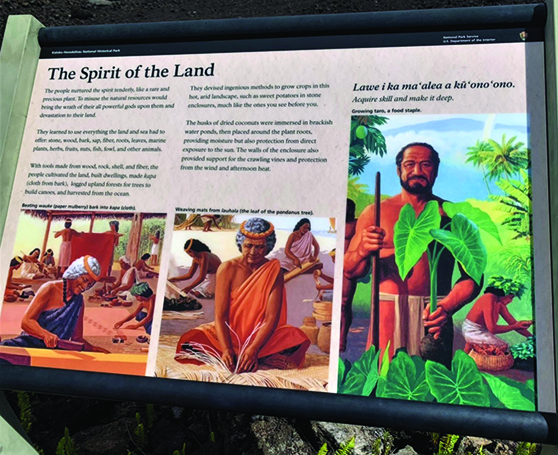
But natives in Hawaii did not let all of that colonization take their culture completely. They still practice their culture and traditional customs to this day. In school, kids start learning their language young so they will be fluent by the time they’re done with school.
While I was there I witnessed a number of ways that the Hawaiian culture continues to thrive, such as creation stories at beaches and waterfalls, luau with adults teaching kids dances, and their traditional language on signs everywhere. These kinds of similarities to cultural revitalization in Tulalip is something that Toni Jo has found comforting while being so far away from Tulalip.
“I’ve always wanted to live here and there are opportunities with education to experience everything Hawaii has to offer,” she said. “Our tribe pays for college education, they pay for school and a lot of the living costs associated with attending a college, like those in Hawaii. I wanted to take that opportunity to show my son that it can be done.”
Toni Jo attended the University of Hawaii at Hilo and received her Bachelor’s Degree in 2021.
In Hawaii there are fishermen, storytellers, language warriors, singers, artists, weavers, and dancers. There are even tribal members like Toni Jo and her son there carving out purpose and creating community with Native Hawaiians who are just like us. They are our island relatives, beautiful and thriving. Just like us.
*Source: https://hawaiianislands.com/blog/the-history-of-hawaii-and-its-culture
Culture Night is back!
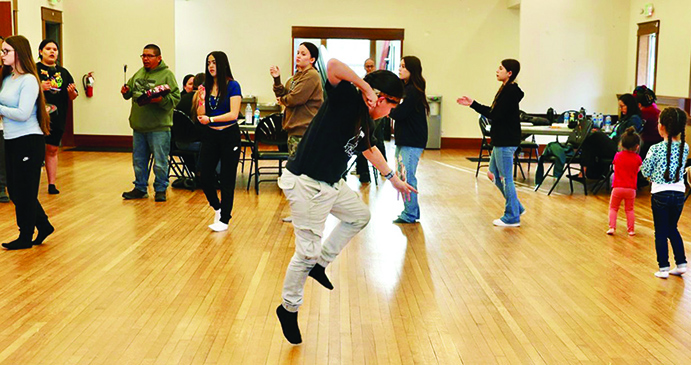
By Kalvin Valdillez, Tulalip News
Over 60 community members helped usher in the spring season on the night of April 9, at the first Culture Night gathering of 2024. For many tribal families, this is a time of year that is dedicated to learning, practicing, engaging, and sharing in the ancestral teachings of the Tulalip people.
With the promise of numerous fun cultural activities on the horizon, including the annual Salmon Ceremony, Canoe Journey, and Spee-Bi-Dah, the Tulalip events department is hosting the weekly Culture Night gatherings, every Tuesday at 5:30 p.m., to help prepare tribal members for the upcoming summertime events.
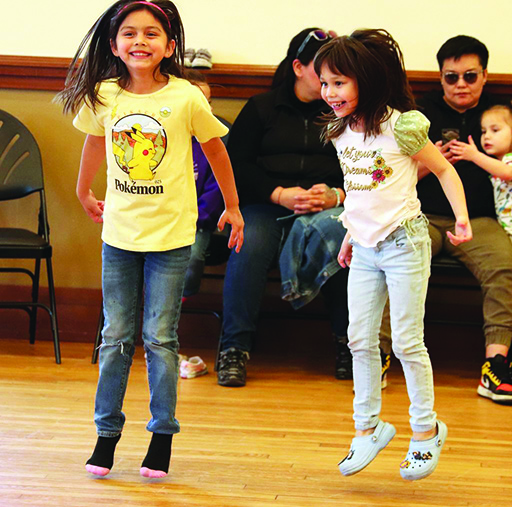
Summer is filled with an abundance of teachings that are important to the tribal nation, such as harvesting traditional foods, plants, and medicines like huckleberries, cedar, salmon, and shellfish. The act of exercising their inherent treaty rights and gathering these items is a significant aspect of the Tulalip culture, which is why it is important for younger generations to learn about the preparation and work that goes into these ceremonies and gatherings, so they can in turn pass it on to the future of the Tribe in the years to come.
At Culture Night, the community gets the chance to learn a handful of Tulalip’s songs and dances that have been passed down throughout the generations. More importantly, they do so at a slower pace, and take the time to show the little ones each step, drumbeat, and chant, so when the time comes, they are able to perform this work at game speed.

Additionally, Culture Night has become synonymous with traditional crafting, due to the fact that many community members utilize the three-hour event to stitch and weave together regalia items for themselves and their families, including shawls, vests, headbands and more. This year, the events department teamed up with the Rediscovery Program for Culture Night. Together, they are making a strong effort to ensure that Tulalip has matching regalia for this summer’s cultural gatherings by providing regalia kits, so families have everything they need to fashion their own traditional attire.
Said Tulalip Events Manager, Malory Simpson, “We’ll be doing kits again this year, so shawl kits and vest kits. And we want to prevent waste, so we’ll be requiring them to check out their kits each week, to make sure projects are completed before they move on. We’re trying to plan, coordinate, and be more uniformed as far as our regalia style. One thing that we will provide this year is a certain color scheme for the material of our regalia.
“I’m excited to see that cohesiveness, coming together as a tribe and representing the Tribe as a whole, overall, in our matching regalia. I really want to see that this year. And if it’s not something that community members want to use, if they want to make their own or use their family colors, they will be responsible for bringing that their selves, but we’ll still have sewing machines and materials available for them to use.”
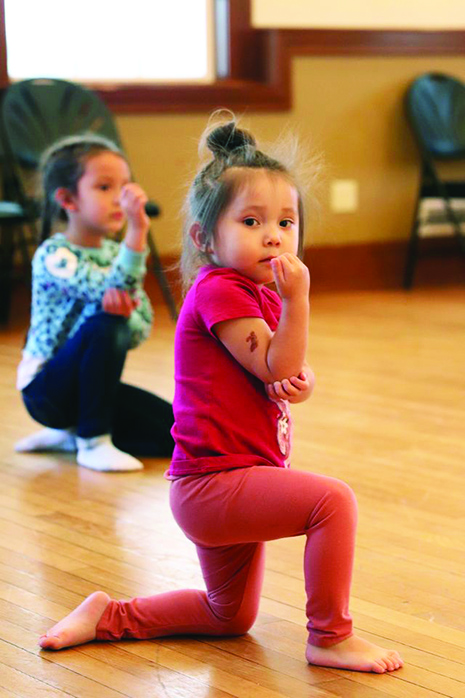
Although the first Culture Night of the year was somewhat lowkey, there was still plenty of buzz in the air in anticipation for the weeks to come, leading up to all those exciting and important cultural events taking place this summer.
This gathering was a great way to get the ball rolling and a wonderful opportunity for the community to share in some fun and laughter together, as well as discuss a number of upcoming events, including the 5:30 p.m. Canoe Washing on Monday April 15, at the Hibulb Cultural Center, and also Salmon Ceremony practice which begins on April 18, at 5:30 p.m., and is set to occur every Thursday at the Gathering Hall until the Salmon Ceremony takes place on June 1. The annual MMIW/P Day on May 3 is another event the community looks forward to participating in each year, and it’s in a space where they are able to put all their teachings that they’ve acquired from attending Culture Night to use, to help spread their healing medicine through that good work.
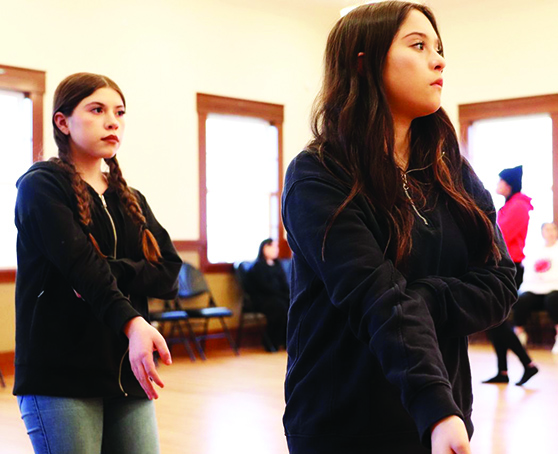
“I’m just excited to gather again and provide a safe place for people to come, enjoy time together, share songs, dance, and learn,” Malory expressed. “This is the time to come out and learn, before we get into the bigger ceremonies. Some people are starting out from ground zero and seeing that growth throughout the weeks is exciting – being able to see that excitement on their faces when they finish their regalia and seeing them at Salmon Ceremony or on Canoe Journey dancing in their regalia, it’s really cool to see all their hard work and their pride when they get to wear it.”
Culture Night is happening every Tuesday from 5:30 p.m. to 8:30 p.m. On April 16, Culture Night will take place at the Tulalip Dining Hall once again. The following weeks, the location will change to the Kenny Moses Building – same time, same day of the week though. Be sure to join in if you would like to craft regalia or practice a few songs and dances with the community.
Reflections from Vietnam Veterans’ Welcome Home Day
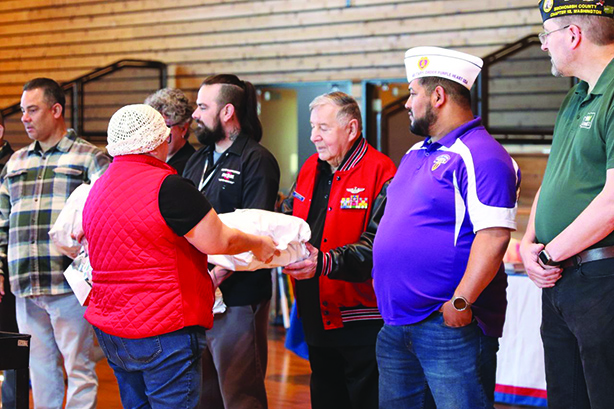
By Wade Sheldon, Tulalip News
On Saturday, March 30, the Gathering Hall became a poignant gathering place as around 100 people convened to commemorate and honor those who served during the Vietnam War. This heartfelt event, known as the Vietnam Veterans Welcome Home Day, was a touching tribute to the sacrifices and contributions of these brave individuals.
Andy James, the event organizer, reflected on its history by stating, “I started hosting this event in 2013 at the Boys and Girls Club. We were shut down when COVID happened, and this one is the first we have been able to have.” The journey to this year’s gathering has been marked by challenges, including the pandemic-induced shutdowns, making this return even more significant.
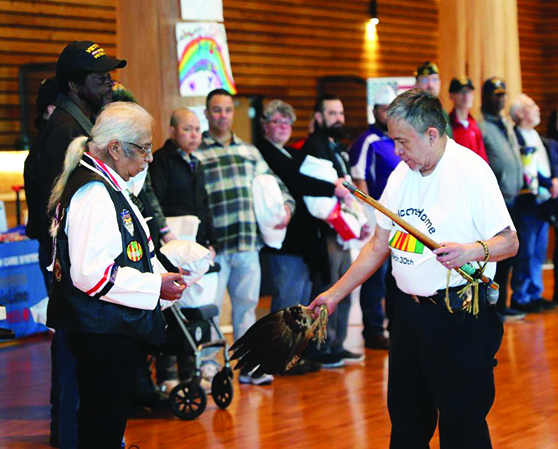
Additionally, March 30 is recognized as Vietnam Veterans Welcome Home Day in Washington State. This day is dedicated to honoring and commemorating the service and sacrifices of Vietnam War veterans. It’s also a day to reflect on the challenges faced by Vietnam veterans upon their return home, as many did not receive the welcome they deserved due to widespread opposition to the war and significant social and political unrest, including protests and demonstrations.
Now, Tulalip’s event serves as an opportunity to express gratitude to those who served during this tumultuous period in history and to remember those who served their country and gave their lives in service to their country.
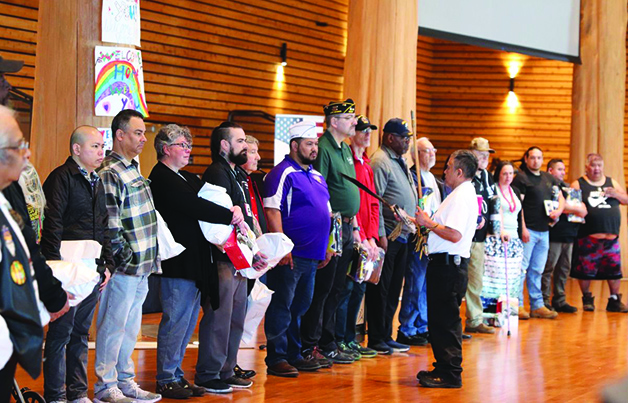
Of the 42,000 Native Americans who served their country during the Vietnam conflict, 90% were volunteers. Among them was Cy Hatch, a retired Gunnery Sergeant from the Tulalip Tribes, who served in the United States Marine Corps and held an E-7 ranking when he retired. This designation meant Cy held a leadership position within his regiment during his 20-year service from 1971 to 1991.
“I didn’t know what to do after I finished high school. I had a brother-in-law who was a Vietnam vet, and he told me to join the Marine Core; I did,” Cy said. “And I managed to make a career out of it, and I’m glad I made that choice. It’s a privilege and an honor to serve your country; I think more people trying to find their way in life should join. I’m thankful for this event; it means a lot for me to stand with my fellow military, be recognized, and enjoy our time together.”
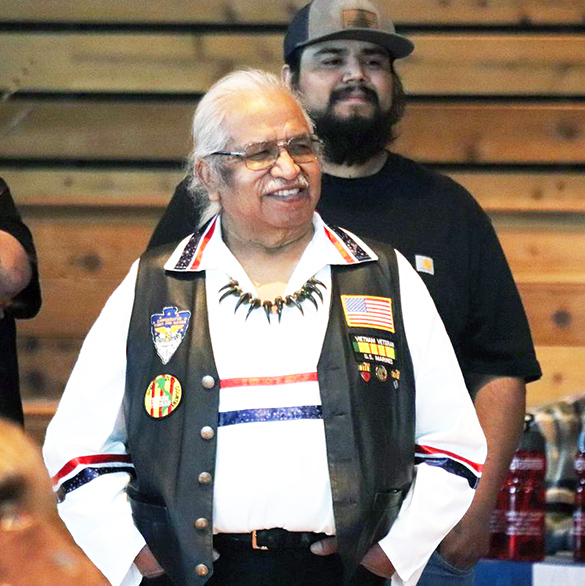
James expressed gratitude for the support received, noting that Governor Jay Inslee signed the Welcome Home Vietnam Veterans Bill in 2013, which has garnered much excitement. “I am particularly thankful to the Tulalip Tribes for their generous offer to host the annual event at the Tulalip Gathering Hall.” As a former Private First Class in the United States Marine Corps during the end of the Vietnam War, James’s motivation for organizing the event is deeply personal. “This is my way of attempting to do something good. Some veterans passed that didn’t get a chance to experience this. I had to do it.” He emphasized the importance of the gathering, reflecting on feedback he’s received: “I have been told this event is so moving and touching, as most don’t get to experience the love our native people extend to its veterans and elders.”
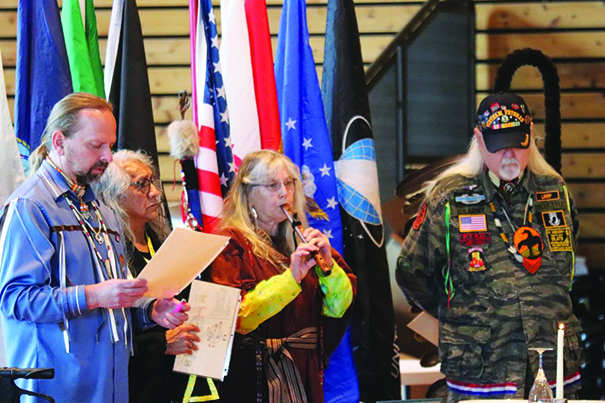
As the event concluded, the camaraderie and appreciation remained palpable. Among heartfelt exchanges, there was a deep sense of gratitude for the opportunity to honor Vietnam veterans. This gathering fostered a sense of community and acceptance, providing solace for the travesties they endured and reaffirming their place within society.
New leadership sworn-in
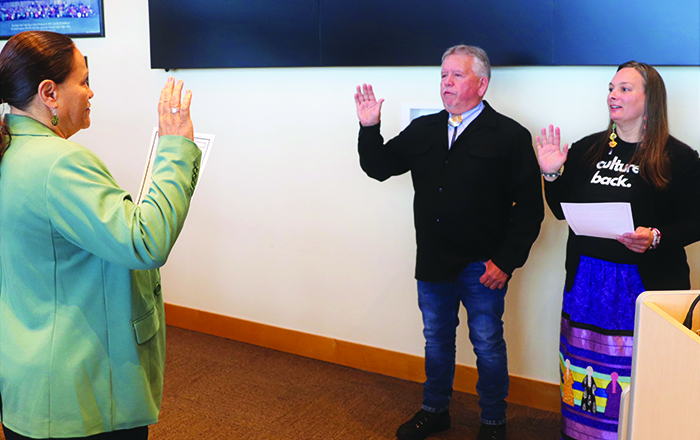
By Micheal Rios, Tulalip News
The latest iteration of Tulalip’s Board of Directors became official on the morning of Saturday, April 6. The regularly scheduled Board meeting began promptly with the first order of business to swear-in the two highest vote getters from March’s general council election: Glen Gobin and Theresa Sheldon.
They replace Pat Contraro, who served one term, and Mel Sheldon, who served for nearly two decades. Mel chose not to run for re-election, while election results showed Pat received the ninth highest total.
After their oaths of office, Glen and Theresa were each given an opportunity to share a few words with those in the room and the many more tuning in on iAmTulalip.com
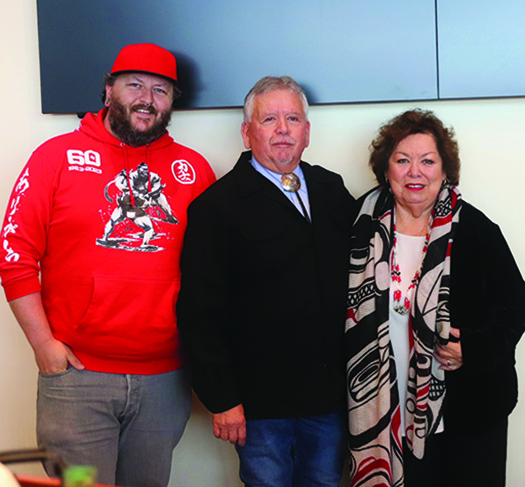
“In many ways it feels like I never left, but in other ways I feel kind of apprehensive for some reason, sitting back up here. I think it comes with the realization of all the responsibility that comes with the position,” admitted Glen. He had previously served as a Board of Director for 15+ years before taking some time off to spend with his family and enjoy the open waters, fishing. “The expectations, by all those who voted for me, are to bring positive change, bring traditional teachings back, and continue to move forward ensuring future generations have the same opportunities we have, if not more.
“I’m glad to be back to help, and look forward to being a part of this team as we work together in the best interest of the Tribe, to move us forward in a good way. Those are the teachings our elders had; it is always about the Tribe first and making sure our membership is secure. Also, I’d like to thank all those who voted for me and encouraged me step forward once more to help the Tribe,” he added.
Glen received the highest vote total during last month’s general election, surpassing all other candidates by a whopping 150 votes.
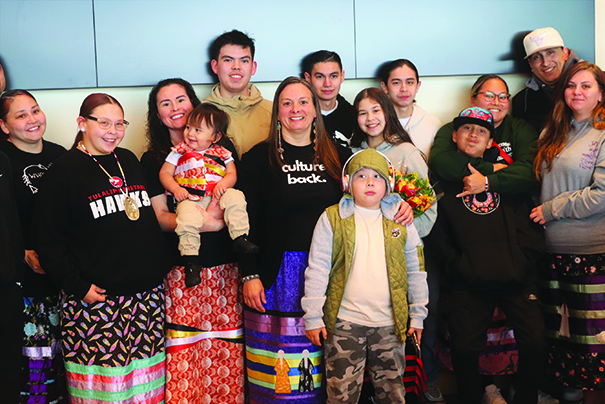
Theresa received the second highest vote total. She returns to the Board of Directors after previously missing out on a second term in 2017 by just nine votes. In her time away, she made a significant impact on Indian Country. First, she served as the Democratic National Committee’s Native American Political Director. Then she stepped down from that position to become Director of Policy and Advocacy for the National Native American Boarding School Healing Coalition.
After getting voted back on to the Board, and subsequently chosen to serve as Madam Secretary, Theresa shared, “I have to first start by expressing my gratitude and love to my babies. This General Council my son, two nephews and two nieces, plus other first-time voters, voted for me as they all voted for their very first time. Understanding I was chosen as the candidate for them, I will never take this responsibility for granted. I must now live up to their expectations.
“Protecting our right to vote, utilizing our right to vote, making sure we have easy access to voting, and voter protection is what I’ve been passionate about for years,” she continued. “I began voter engagement in 2007 and continued to work diligently for Native Vote at the county level, state level, and national level. Never would I have thought back then that my family’s babies at the time would grow up and cast their first vote for me.
“This is a reminder to all those who doubt the power of our younger generation that they have the capacity to create historical change. I am so grateful to our young people and want them to know I hear them and I see them demanding more from all of us; in demanding their language, in demanding their songs, and in demanding their culture. To everyone who supported me,t’igʷicid! To those who did not support me, I will work hard for you, too, as I want us all to succeed.”
For decades addiction, housing, child welfare, economic development, treaty rights and sovereignty have dominated Tulalip’s political discourse. Glen and Theresa both campaigned with an emphasis on their work ethics, diverse experience, and commitment to the people.
Concluding the induction of Tulalip’s newest leaders, Chairwoman Gobin said, “Both of them have served on Council before. They bring so much valuable leadership and knowledge to our team, and I’m excited to see how much we can get accomplished with as strong a Board as we have now.”
April 6, 2024 syəcəb
Use the following link to download the April 6, 2024 issue of the syəcəb
Youth Services Easter Bash
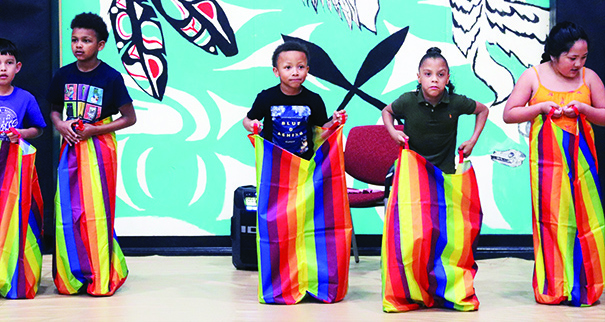
By Micheal Rios, Tulalip News
Hundreds hippity hopped to an early Easter Bash hosted at Tulalip’s Youth Center on Saturday, March 30. There were dyed eggs galore, coloring stations, plenty of Easter themed backdrops for pictures, and energy-inducing sugary treats. However, nothing topped the pure joy of children eager to meet their imaginary icon, the Easter bunny.
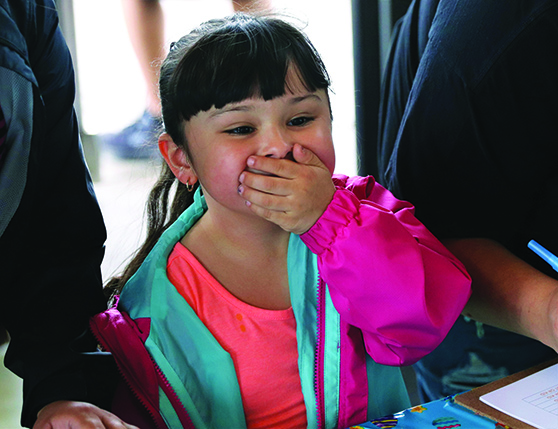

“The Easter Bash was a huge success,” said Sheena Oldham, one of the event coordinators. Serving as an activities specialist and proud mom of three kids, she was well versed in what a proper Easter party required. “I feel like our Bash brought a ton of people together. I’m proud of your Youth Services staff for all they did behind the scenes to make this happen, including wearing the bunny suit.
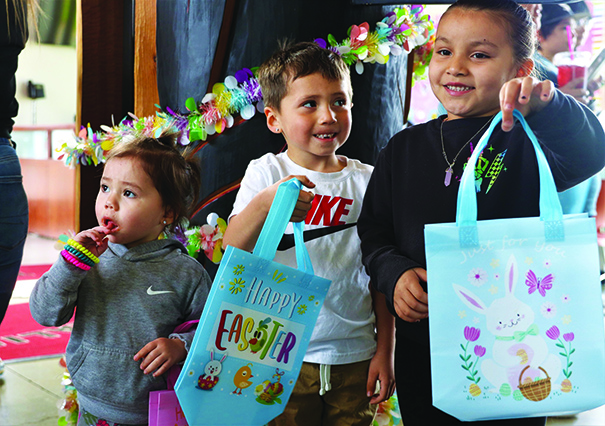
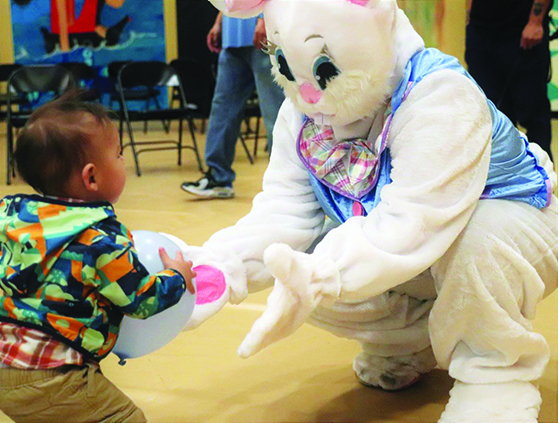
“The games, the food, the racing to get eggs, you could see how much everything meant to the kids who were running around endlessly from one activity to another,” she added. “Personally, my favorite aspect was seeing the competitive atmosphere from both parents and kids when it came time to the egg hunt. It was all smiles throughout and we saw so many people taking and sharing pictures of their happy kids. It’s events like this that really show how much our community appreciates getting together and having fun.”
Easter Bunny brings literary joy to TELA
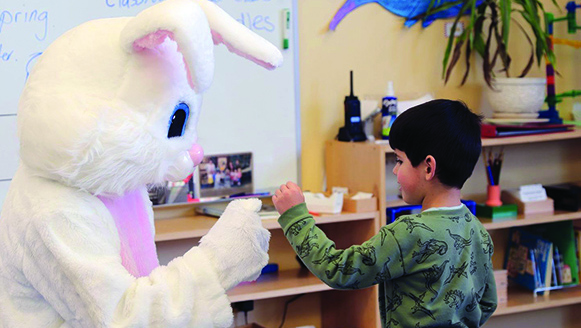
By Wade Sheldon, Tulalip News
In a heartwarming event that brought smiles to children’s faces at the Betty J. Taylor Early Learning Academy (TELA), the Easter Bunny appeared on Thursday, March 28 to distribute books and cookies, spreading joy and excitement among the young learners. The happy bunny made his way through every classroom.

Students would either run up to give a high five or pound fists, while some held back as they weren’t sure of the furry creature standing in their room. One student said, “That’s a big bunny.” Another student remarked, “Can he hop like a little bunny?”
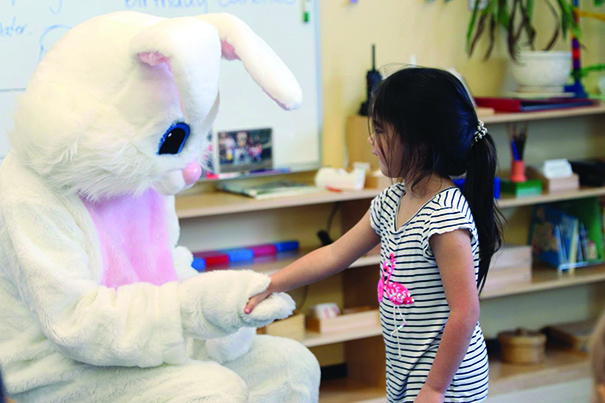
This year, TELA is working on consent. The teachers instructed the students to ask the bunny for consent before trying to hug the bunny.
And as a special treat, a copy of the book, ‘Coast Salish ABCs’ by TELA counselor and tribal member, Marysa Sylvester, was given to each child. “It felt very cool,” Marysa said. “I didn’t think my ABC book would be picked; I am very grateful that the Academy chose my book. I feel very blessed, and I think it’s awesome.”
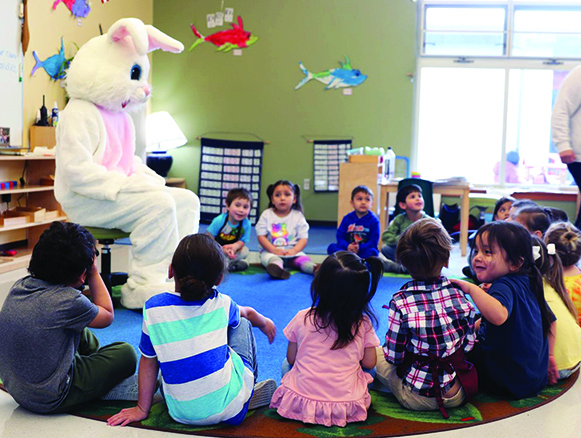
“There are many positives to early learning reading,” teacher assistant Absyde Dacoscos said. “It exposes the kids to language literacy and letter recognition. We want to provide books to encourage families to go home and read together. The Co-Salish ABC’s book is a bonus, allowing them to see the cultural designs while teaching the ABCs.”
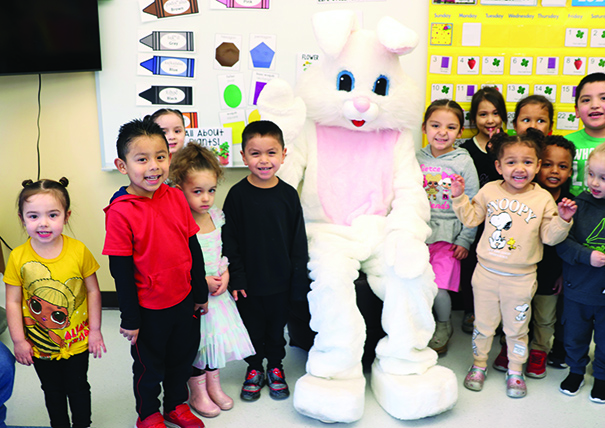
As the children bid farewell to their furry friend, TELA concluded yet another successful event dedicated to spreading happiness and fostering a love for learning.
Easter Bunny and Sparky return for annual Easter Run

By Kalvin Valdillez, Tulalip News
The kids of Tulalip could not contain their excitement on the afternoon of Saturday, March 30. Many were literally jumping with joy when they spotted two life size characters strolling down their street. And though some of the kiddos were initially terrified, a few of them put on their brave faces and overcame their fear once they were gifted candy and toys from Sparky the Fire Dog and the Easter Bunny.
A year into the COVID-19 pandemic, a local nonprofit known as Together We’re Better organized the first Easter Run for the community of Tulalip in 2021. The event was an instant success and helped raise the spirits of the entire reservation. With gathering restrictions in place, With gathering restrictions in place, and while many folks were practicing social distancing, the Easter Run brought back a sense of normalcy to the community.
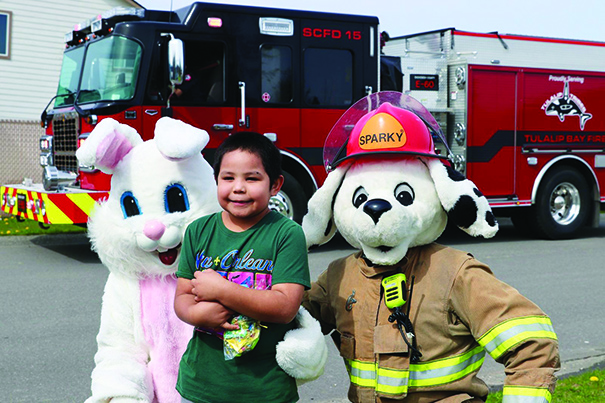
At the time, Together We’re Better Founder, Malory Simpson, shared, “It was important for us to do an event. Normally, we do a huge egg hunt and multiple communities come out to celebrate, but COVID has interfered with a lot of events this year. Together We’re Better is community-driven and 100% community funded, so seeing the kids cooped up and not having anything really planned for them, we wanted to do something for them and bring Easter to the community.”
Malory drew inspiration from the Tulalip Bay Fire Department’s yearly Santa Run, in which the Fire squad escorts Santa Claus throughout Tulalip neighborhoods while collecting donations for the Tulalip Church of God Food Bank. When Malory reached out to the fire station, a partnership was quickly forged between Together We’re Better and the Tulalip Bay Fire Department. Their firehouse dalmatian mascot, Sparky, also wanted in on the fun and volunteered to distribute candy alongside the Easter Bunny.
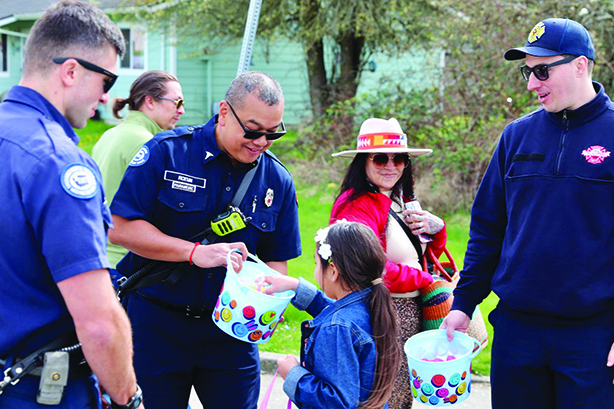
“When you see the kid’s faces light up, and their smiles are so big, ear to ear, when they see Easter Bunny and Sparky from across the road, it’s just the best,” expressed TBFD Captain John Carlson. “The interactions are always great; they all mean a lot to us. To make their day makes my day, because we see people on some of their worst days. I view the fire services as a family and the Tulalip community is a huge part of our family too. It’s so great to work together and make each other’s day better, it means a lot to us. It’s why we’re here.”
In addition to Sparky and the fire crew, two other local groups volunteer their time to hand out candy each year and are essential to the Easter Run – Aunties in Action and the Redrum First Nations Motorcycle Club. Every Easter Run, there are about 20 volunteers who walk numerous miles throughout the day to deliver treats and smiles to the homes of Tulalip children and their families.
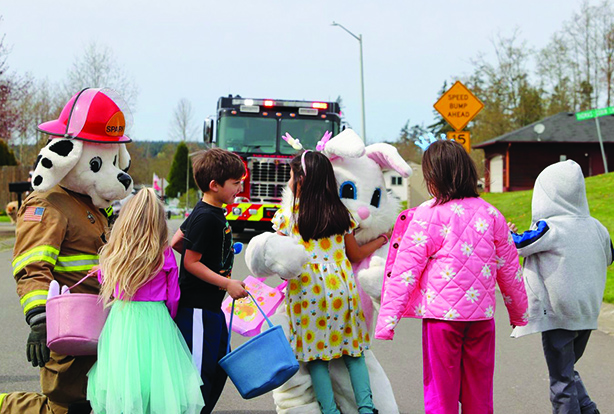
The Easter Run was such a big hit within the community that Together We’re Better decided to make it an annual occasion. Now, it is something that many kids look forward to each spring. Kids are on the lookout, peering out their windows, and as soon as they catch a glimpse of the dynamic duo, they are outside waiting to greet them.The kids shower the bunny and fire dog with hugs and high fives, and graciously accept their gifts of sugar and plastic novelties. The parents are equally as excited as the youngins, and they are sure to have their camera apps open and ready to snap a shot of their babies with the two loveable characters.
Said Malory, “Giving back to the community always feels really good. This is all community effort; it makes my heart happy to see the community coming together to take care of each other. I just love it. The smiles and laughter make you feel really good inside. Just seeing the kids get excited is one of the best things about the event. It’s pretty fun to see all of their reactions and see how happy the kids are to spend some time with the Easter Bunny and Sparky.”
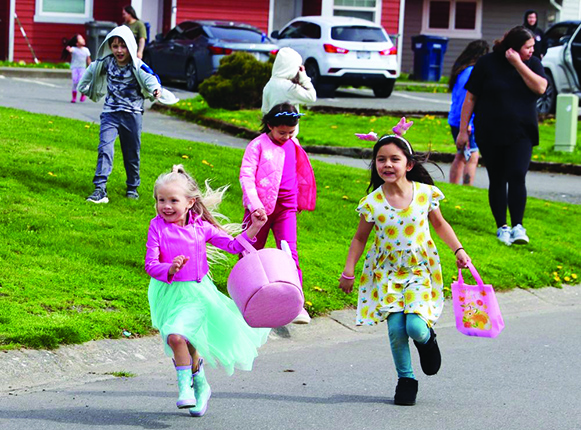
This year, the Tulalip Bay Fire Department expanded its district to include homes located in the Quil Ceda Creek neighborhood developments. As the Easter Run mirrors the fire department’s service area, this meant that the Easter Bunny and Sparky would see some new faces this year. And that they did. With the addition of three neighborhoods, Sparky and the bunny made dozens of new friends of all ages, from newborns to elders, as they spent a generous portion of their day getting to know the kids and families on the Quil.
In total, the Easter Bunny and Sparky visited 10 neighborhoods on the reservation, walked over 14,000 steps (≈ 7 miles), and brought smiles to over 100 kids during the 2024 Easter Run.
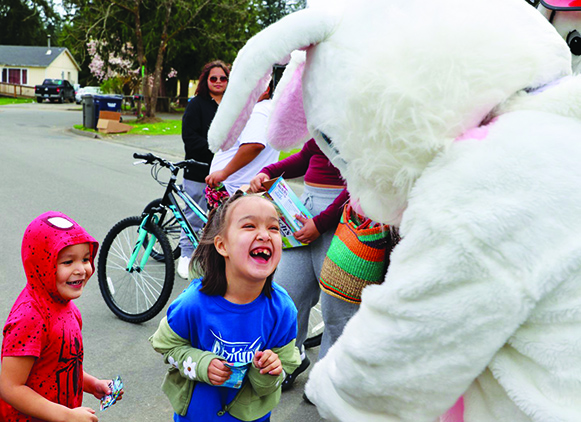
Natosha Gobin, the 2024 Easter Run event planner, stated, “The Together We’re Better events are so much fun to participate in because it is community driven. For the Easter Run, a lot of community members look forward to stuffing eggs, buying snacks, and doing whatever they can to help. It’s nice to take time and visit with the families and go to all the different developments. This year, we were excited to add the Quil developments as well. It feels so good to be with the community for a positive reason. And to see how much this means to the family as a whole – it just feels really good to be a part of something that is putting smiles on their faces.”
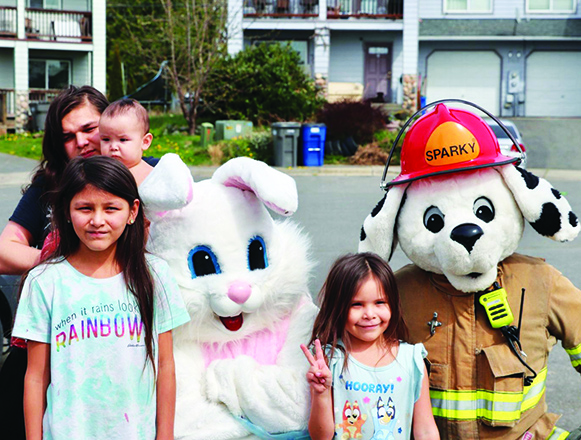
If you are looking to get more involved with the community, Together We’re Better is always accepting donations, whether that is goods, funds, or your personal volunteered time. For more information, please contact Natosha Gobin at (425) 319-4416 or Malory Simpson at (425) 905-9137.
Symmetria Medical donates $10,000 to Tulalip Boys & Girls Club
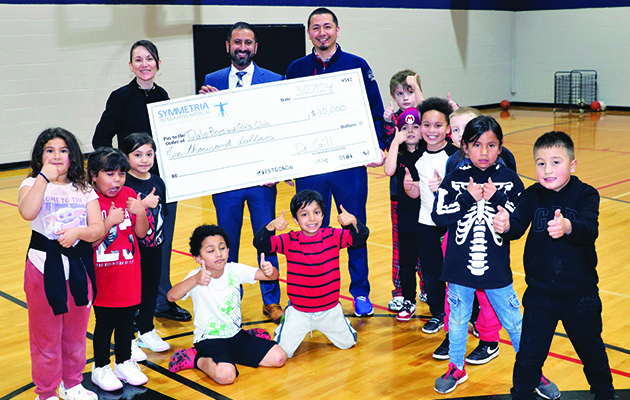
By Micheal Rios, Tulalip News
Within our shared Tulalip/Marysville community are organizations staffed with dedicated professionals who prioritize health and well-being. These professionals are well aware that in order to have a culturally vibrant community, the individuals within the community, child to elder, must be physically, mentally, and spiritually healthy.
Recognizing this, medical establishments like Symmetria Integrative Medical play a pivotal role not only in providing healthcare services but also in creating community well-being through philanthropic efforts, such as making a large financial donation to our reservation’s Boys & Girls Club. Their recent $10,000 contribution extends the impact of healthcare providers beyond the confines of clinics and injected pure excitement and goodwill into the heart of the community.
That excitement is best demonstrated by reliving a super cute moment shared by all those within earshot of two jubilant youth preparing to take a picture with the gigantic cardboard check.
“We got $1,000!”
“Nu-huh! We got $10,000!”
“Ten-thousand?! We’re rich!”
Then in unison and completely unprompted, they shouted “Yay!’
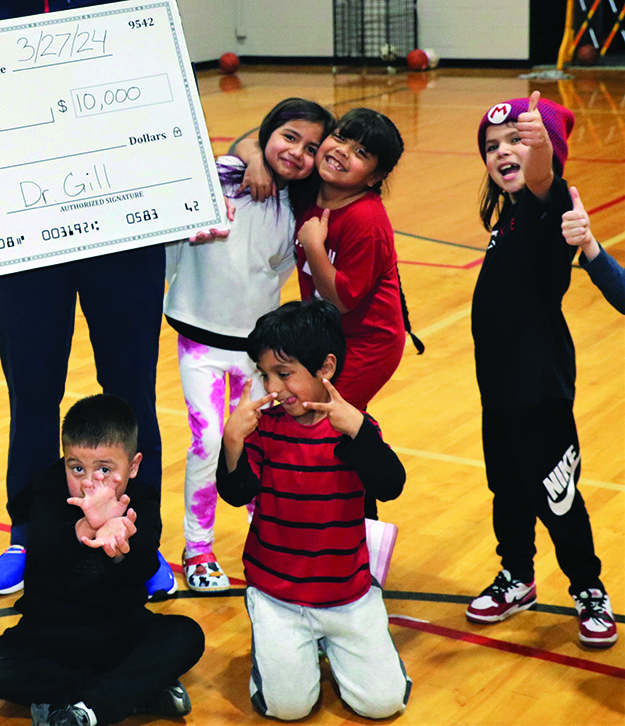
That moment may have only lasted mere seconds, but the feels it generated, much like the $10,000 worth of support and supplies to be purchased, can leave a long-lasting impact for those for whom the local Club is a sanctuary.
“It’s important we share moments like this with the kids because its important they understand that people really care for them,” shared Tulalip Club director Shawn Sanchey. “Our Club kids are supported by those on and off the Rez and by those who aren’t here everyday with them, but who still contribute in a significant way that helps us develop programs and services which allow our kids to grow in a good way. Ultimately, I feel we can do and should do a better job as adults to help our kids understand there are people and even entire organizations out there who truly care about them and care about their successes.”
Our local boys & girls club offers a comprehensive collection of programs designed to promote the holistic development of Tulalip’s next generation. According to Grandma Diane’s latest estimations, the Club serves over 275 kids daily. From biddy ball everything to culturally relevant arts and crafts to the tech-driven future that is here now, the Club’s programs address critical areas of development for each one of those 275 kids. Each one of them has access to range of services that include education assistance, athletic support, and something as seemingly simple as access to hot meals and nutritional snacks.
“I grew up in Marysville. I went to Marysville Pilchuck High School, and I’ve always viewed the citizens of Tulalip as part of my community,” said Dr. Baljinder Gill, Symmetria president and operations director. “Now that I’m in the position of running a community-based clinic, I want to give back in way that now only supports the Tribe, but also builds upon the relationship of trust for its membership.
“The Tulalip Boys & Girls Club is so advanced, and being here today I can feel just how much trust the kids have for the staff and in turn how much the staff really cares for the kids,” added Dr. Gill. “This environment is what my clinic strives to emulate with its patient/provider relationship. It’s worth mentioning that a few years ago, the Tulalip Board of Directors passed a resolution that gives Tulalip tribal members coverage in our office. Plus, anyone who work with the Tribe and has HMA coverage, depending on the plan level they have, almost all our services are covered at 100%.”
By donating such a large sum to our Boys & Girls Club, Dr. Gill and his Symmetria clinic are doing much more than providing financial support, they are investing in the health and future of the community. To quote those previously mentioned Club kids, “Yay!”